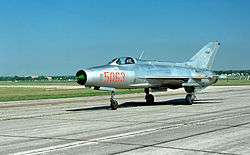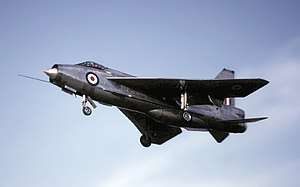Second-generation jet fighter
Second-generation jet fighters are jet fighter aircraft that were developed between the mid-1950s and the early 1960s.
Development
The development of second-generation fighters was shaped by technological breakthroughs, lessons learned from the aerial battles of the Korean War, and a focus on conducting operations in a nuclear warfare environment. Technological advances in aerodynamics, propulsion and aerospace building materials (primarily aluminum alloys) permitted designers to experiment with aeronautical innovations, such as swept wings, delta wings, and area-ruled fuselages. Widespread use of after-burning turbojet engines made these the first production aircraft to break the sound barrier, and the ability to sustain supersonic speeds in level flight became a common capability amongst fighters of this generation.
Electronics
Fighter designs also took advantage of new electronics technologies that made effective radars small enough to be carried aboard smaller aircraft. Onboard radars permitted detection of enemy aircraft beyond visual range, thereby improving the handoff of targets by longer-ranged ground-based warning and tracking radars. Similarly, advances in guided missile development allowed air-to-air missiles to begin supplementing the gun as the primary offensive weapon for the first time in fighter history. During this period, passive Infrared homing became commonplace, but early IR missile sensors had poor sensitivity and a very narrow field of view (typically no more than 30°), which limited their effective use to only close-range, tail-chase engagements. Radar-guided (RF) missiles were introduced as well, but early examples proved unreliable. These semi-active radar homing (SARH) missiles could track and intercept an enemy aircraft "painted" by the launching aircraft's onboard radar. Medium- and long-range RF air-to-air missiles promised to open up a new dimension of "beyond-visual-range" (BVR) combat, and much effort was placed in further development of this technology.

Weapons
The prospect of a potential third world war featuring large mechanized armies and nuclear weapon strikes led to a degree of specialization along two design approaches: interceptors (like the English Electric Lightning and Sukhoi Su-9) and fighter-bombers (such as the Republic F-105 Thunderchief and the Sukhoi Su-7). Dogfighting, per se, was deemphasized in both cases. The interceptor was an outgrowth of the vision that guided missiles would completely replace guns and combat would take place at beyond visual ranges. As a result, interceptors were designed with a large missile payload and a powerful radar, sacrificing agility in favour of high speed, altitude ceiling and rate of climb. With a primary air defence role, emphasis was placed on the ability to intercept strategic bombers flying at high altitudes. Specialized point-defence interceptors often had limited range and little, if any, ground-attack capabilities. Fighter-bombers could swing between air superiority and ground-attack roles, and were often designed for a high-speed, low-altitude dash to deliver their ordnance. Television- and IR-guided air-to-surface missiles were introduced to augment traditional gravity bombs, and some were also equipped to deliver a nuclear bomb.
Types
| Aircraft | Origin | Number built |
First flight |
Service life |
Length m |
Wingspan m |
Wing area sq. m |
Empty weight |
Max takeoff weight |
Max Speed km/h |
Range km |
Ceiling m |
Engine × thrust |
|---|---|---|---|---|---|---|---|---|---|---|---|---|---|
| Vought F-8 Crusader | 1,219 | 1955 | 1957–1999 | 16.53 | 10.87 | 34.80 | 7,956 kg | 13,000 kg | 1,975 | 2,795 | 17,700 | 1 × 47.6 kN/80.1 kN | |
| Convair F-102 Delta Dagger | 1,000 | 1953 | 1956–1979 | 20.83 | 11.61 | 64.57 | 8,777 kg | 14,300 kg | 1,304 | 2,175 | 16,300 | 1 × 52.0 kN/76.5 kN | |
| Convair F-106 Delta Dart | 342 | 1956 | 1959–1988 | 21.55 | 11.67 | 64.57 | 11,077 kg | 15,670 kg | 2,455 | 2,900 | 17,000 | 1 × 109.0 kN | |
| Douglas F4D Skyray | 422 | 1951 | 1956–1964 | 13.80 | 10.21 | 52.00 | 7,268 kg | 10,273 kg | 1,162 | 1,100 | 17,000 | 1 × 45.0 kN/71.0 kN | |
| Grumman F-11 Tiger | 200 | 1954 | 1956–1969 | 14.3 | 9.6 | 23.00 | 6,277 kg | 10,663 kg | 1,170 | 2,050 | 14,900 | 1 × 32.9 kN/46.7 kN | |
| Lockheed F-104 Starfighter | 2,578 | 1954 | 1958–2004 | 16.66 | 6.36 | 18.22 | 6,350 kg | 13,170 kg | 2,137 | 2,623 | 15,000 | 1 × 48.0 kN/69.0 kN | |
| McDonnell F-101 Voodoo | 807 | 1954 | 1957–1984 | 20.55 | 12.09 | 34.20 | 12,925 kg | 23,770 kg | 1,825 | 2,450 | 17,800 | 2 × 53.3 kN/75.2 kN | |
| North American F-100 Super Sabre | 2,294 | 1953 | 1954–1988 | 15.20 | 11.81 | 37.00 | 9,500 kg | 15,800 kg | 1,390 | 3,320 | 15,000 | 1 × 45.0 kN/71.0 kN | |
| F-5 Freedom Fighter | 2,246 | 1959 | 1962-1998 | 14.30 | 7.69 | 15.79 | 5,973 kg | 9,008 kg | 1,715 | 2,253 | 15,240 | 2 × 18.15 kN | |
| Republic F-105 Thunderchief | 833 | 1955 | 1958–1984 | 19.63 | 11.25 | 35.76 | 12,470 kg | 23,834 kg | 2,208 | 3,550 | 14,800 | 1 × 63.74 kN/109.0 kN | |
| English Electric Lightning | 337 | 1954 | 1959–1988 | 16.80 | 10.60 | 44.08 | 14,092 kg | 20,752 kg | 2,400 | 1,370 | 18,240 | 2 × 55.74 kN/71.17 kN | |
| Folland Gnat | 449 | 1955 | 1959–1991 | 8.74 | 6.73 | 12.69 | 2,175 kg | 4,100 kg | 1,120 | 800 | 14,630 | 1 × 20.9 kN | |
| Supermarine Scimitar | 76 | 1956 | 1957–1969 | 16.84 | 11.33 | 45.06 | 10,869 kg | 15,513 kg | 1,185 | 2,289 | 14,000 | 2 × 50.1 kN | |
| Dassault Super Mystère | 180 | 1955 | 1957–1977 | 14.13 | 10.51 | 32.00 | 6,390 kg | 10,000 kg | 1,195 | 1,175 | 17,000 | 1 × 33.3 kN/44.1 kN | |
| Dassault Étendard IV | 90 | 1958 | 1962–1991 | 14.40 | 9.60 | 29.00 | 5,900 kg | 10,200 kg | 1,099 | 3,300 | 15,500 | 1 × 43.16 kN | |
| Dassault Mirage III | 1,422 | 1956 | 1961–present | 15.03 | 8.22 | 34.85 | 7,050 kg | 13,700 kg | 2,350 | 4,000 | 17,000 | 1 × 41.97 kN/60.8 kN | |
| Dassault Mirage 5 | 582 | 1967 | 1969–present | 15.03 | 8.22 | 34.85 | 7,050 kg | 13,700 kg | 2,350 | 4,000 | 18,000 | 1 × 41.97 kN/60.8 kN | |
| Fiat G.91 | 770 | 1956 | 1958–1995 | 10.03 | 8.56 | 16.4 | 3,100 kg | 5,500 kg | 1,075 | 1,150 | 13,100 | 1 × 22.2 kN | |
| IAI Nesher | 61 | 1971 | 1972–2012 | 15.65 | 8.22 | 34.80 | 6,600 kg | 13,500 kg | 2,230 | 1,300 | 17,680 | 1 × 41.97 kN/60.8 kN | |
| Saab 35 Draken | 651 | 1955 | 1960–2005 | 15.35 | 9.42 | 49.22 | 7,865 kg | 11,400 kg | 2,124 | 3,250 | 18,000 | 1 × 56.5 kN/78.4 kN | |
| Mikoyan-Gurevich MiG-19 | 2,172 | 1953 | 1955–present | 12.54 | 9.00 | 25.00 | 5,447 kg | 7,560 kg | 1,455 | 2,200 | 17,500 | 2 × 25.5 kN/31.8 kN | |
| Mikoyan-Gurevich MiG-21 | 11,496 | 1955 | 1959–present | 15.00 | 7.15 | 23.00 | 5,339 kg | 8,725 kg | 2,237 | 1,210 | 17,800 | 1 × 40.21 kN/69.62 kN | |
| Sukhoi Su-7 | 1,847 | 1955 | 1959–1990 | 16.80 | 9.31 | 34.00 | 8,937 kg | 15,210 kg | 2,150 | 1,650 | 17,600 | 1 × 66.6 kN/94.1 kN | |
| Sukhoi Su-9 | 1,150 | 1956 | 1959-1970s | 17.37 | 8.43 | 34.00 | 8,620 kg | 12,250 kg | 2,135 | 1,125 | 16,760 | 1 × 67.1 kN/98.1 kN | |
| Shenyang J-6 | 3,000 | 1958 | 1961–2002 | 12.54 | 9.20 | 25.00 | 5,447 kg | 7,560 kg | 1,540 | 2,200 | 17,900 | 2 × 29.0 kN/36.78 kN | |
| Chengdu J-7 | 2,400 | 1966 | 1960s–present | 14.88 | 8.32 | 24.88 | 5,292 kg | 9,100 kg | 2,200 | 2,200 | 17,500 | 1 × 44.1 kN/64.7 kN | |
| HAL HF-24 Marut | 147 | 1961 | 1964–1985 | 15.87 | 9.00 | 28.00 | 6,195 kg | 10,908 kg | 1,112 | 13,750 | 2 × 21.57 kN | ||
Note: Thrust Dry/Afterburner (in some cases only data for one of the two might be available)
This generational era also saw the introduction of VTOL aircraft such as:
| Aircraft | Primary Builder |
Number built |
First flight |
Service life |
Length m |
Wingspan m |
Wing area sq. m |
Empty weight |
Max takeoff weight |
Max Speed km/h |
Range km |
Ceiling m |
Engines × Thrust |
|---|---|---|---|---|---|---|---|---|---|---|---|---|---|
| Hawker Siddeley Harrier | 278 | 1967 | 1969–2006 | 14.27 | 7.70 | 18.68 | 6,140 kg | 11,430 kg | 1,176 | 3,425 | 15,600 | 1 × 95.6 kN | |
| Yakovlev Yak-38 | 231 | 1971 | 1976–1991 | 16.37 | 7.32 | 18.50 | 7,385 kg | 11,300 kg | 1,280 | 1,300 | 11,000 | 1 × 66.7 kN 2 × 31.9 kN | |
Canceled Aircraft

.svg.png)
- Avro Canada CF-105 Arrow (maiden flight on 25 March 1958)

- Helwan HA-300 (maiden flight on 7 March 1964)
